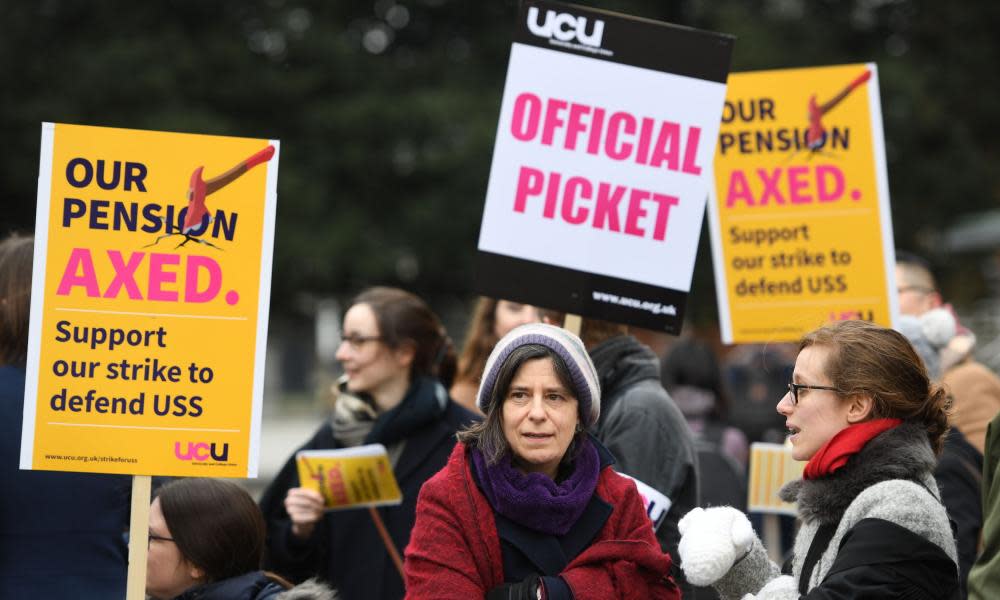The solution to university pensions? Better fund managers

Never have university pensions been so firmly in the media spotlight as this week. But why are the changes to the universities superannuation scheme (USS) so controversial? Views diverge wildly: vice-chancellors and their representatives say future pensions are unsustainable, while staff see a strongly performing scheme. With an estimated cost of £200,000 to the average member of staff over their retirement at stake, something had to give.
Pensions are complex. To try to understand them, we need to go back to basics. Defined benefit pensions involve employees agreeing a monthly contribution with their employer. The employer matches it at an agreed rate, with the pension at retirement guaranteed – or defined. Both contributions are folded into the pension fund, with some covering the costs of current pensioners and the rest invested to secure returns, keeping track with rising prices. In theory, the fund’s boat should be lifted with rising economic tides.
The problem is that the boats these pensions are invested in are defying the expected tidal forces. Between 2000 and 2009, investment returns rose so quickly that firms were allowed contribution holidays. It was argued that the excess cash could be better invested in new buildings.
We now know that these forces were a figment of the financial sector’s imagination. The destruction of value and collapse of interest rates has meant that, for investors, the economic tide has gone out and their boats have been stranded – with our pension pots inside them.
What happens now is anybody’s guess. Life-changing decisions shaping trillions in pension funds are being made on the back of guesswork masquerading as science.
The projections on which the USS cuts are based claim the fund will be unable to keep up with future pension payments. This supposed deficit is growing as life expectancy increases. This is compounded by actuarial wizardry suggesting it will cost significantly more to buy future pensions largely because the investments in the fund are expected to have less purchasing power. The boats remain stranded on the beaches of low investment returns.
The point is, anybody can project anything – including future pension liabilities. Yet the finance industry’s track record of estimating our future economy is woeful. Estimates of the costs of buying future pensions by the vice-chancellors’ actuarial consultants vary incomprehensibly. So incomprehensibly that many cannot fathom the calculations.
Estimates of the costs of buying future pensions by the vice-chancellors’ actuarial consultants vary incomprehensibly
Most people prefer to deal with facts. Here they are: current employees pay £2.1bn into the USS fund, which comfortably absorbs the £1.8bn paid to pensioners each year. The USS asset managers need a net annual return of only 3% from the massive £60bn fund to cover these costs – before considering the billions that employed staff contribute each year, which more than cover the estimated cost of future pensions. The good ship USS pension fund is well and truly afloat. It’s never run aground in its history.
But with the sleight of an actuarial hand, this rosy picture turns into a financial nightmare. The guiding star most pension analysts follow leads to safe investments, like the government AA-rated gilts used by the USS. Returns on AA gilts have been at record lows due to the complexities of quantitative easing and its distortion of returns on bonds and the wider financial markets. But the world is changing: the investment strategies of some of the world’s largest and most respectable pensions are moving from ultra-safe bonds towards riskier equities.
Yes, there is risk, but look at it this way. You have an annual income of £21,000. Your outgoings are £18,000 but expected to increase. You have £600,000 invested in a mixed portfolio of balanced risk. Could you cover your future outgoings?
Add a few zeros, keep the ratios, and you have the USS’s current situation. Its fund managers claim they can’t make these numbers work. Other fund managers think they can. Perhaps it’s time to invest the £60bn fund with a wider group of asset managers who are more willing to take on risk.
The alternative is a £200,000 reduction in the value of each staff member’s pension, which is no longer guaranteed or defined but subject to the fluctuations of the market at the time they retire. When the alternative is bleak, sometimes the riskiest route is worth taking.
Anthony Hesketh is a senior lecturer at Lancaster University Management School
Join the higher education network for more comment, analysis and job opportunities, direct to your inbox. Follow us on Twitter @gdnhighered. And if you have an idea for a story, please read our guidelines and email your pitch to us at highereducationnetwork@theguardian.com
Looking for a higher education job? Or perhaps you need to recruit university staff? Take a look at Guardian Jobs, the higher education specialist

 Yahoo News
Yahoo News 
